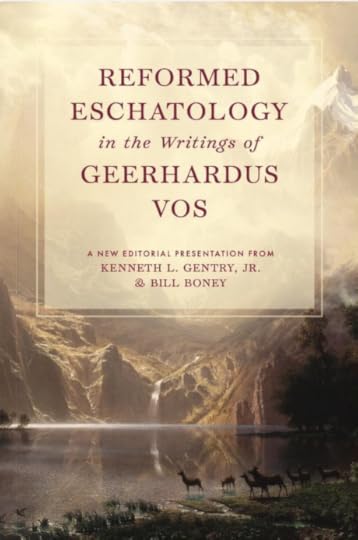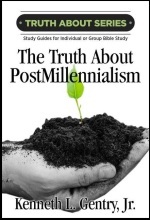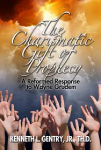TWO AGES ARE NOT TWO COVENANTS
 PMW 2024-095 by Kenneth L. Gentry, Jr.
PMW 2024-095 by Kenneth L. Gentry, Jr.
Through my GoodBirth Ministries I am seeking to raise support to allow me to work virtually full time on a new book on the two ages of redemptive history. This two-age concept, along with its corollary, the “Now but Not Yet” principle, are essential for understanding God’s plan in history. Much confusion regarding this matter reigns among evangelical Christians, especially among those who are not well-trained in academic issues related to eschatology.
In this article I simply want to briefly introduce the idea of the two ages. And I want to do so by showing that it has wide support among the three major eschatological views (obviously excluding dispensationalism, which is losing its academic voice in the market place of ideas). In my planned book on the two ages, I will provide about 250 pages of arguments to flesh out this crucial matter. But for now, I will show that I am not alone!
Postmillennialist Dr. Greg L. Bahnsen (Victory in Jesus, 131-32)
“From the fact that ‘this world’ is interchangeable with ‘this age’ (e.g., 1 Cor. 1:20ff; 2:16; 3:19), we infer that the phrase ‘this age’ can also be understood as referring to an ethical or spiritual realm, rather than exclusively to a set period of time.
“From the perspective of New Testament theology, the ‘age to come’ has broken in on ‘this age’; those who are saved now enjoy the presence of the future age. With the first advent of Christ, God’s ordained moment has arrived (Gal. 4:4), the kingdom has drawn near (Matt. 3:2; 4:17; 10:7; Mark 1:15; Luke 10:9, 11), the great jubilee has arrived (Luke 4:!6–21), the good news of the kingdom has come into effect (Luke 16:16; Matt. 11:2–15), the Old Testament promise has been realized (Rom. 1:2; 16:25–26), the messianic marriage supper has approached (Mark 2:18–22).
“With the coming of the Spirit at Pentecost, the ‘last days’ of Joel’s prophecy have arrived, and God’s Anointed is declared to be permanently enthroned in David’s kingdom (Acts 2); this Spirit is our down payment (‘earnest’) on the future inheritance (2 Cor. 1:22; 5:5; Eph. 1:14) and the first-fruits of the resurrection order (Rom. 8:23; cf. Col. 1:18). The kingdom of God and coming age have been installed.
“After a long period of anticipation, God has now spoken to us by His Son ‘at the end of these days’ (Heb. 1:2). Christ has been manifest ‘at the end of the ages’ (Heb. 9:26), ‘in the last times’ (I Pet. 1:20). Consequently, ‘the ends of the ages has arrived’ (1 Cor. 10:11). The eschatological age has already begun, which means that ‘this age’ and ‘the age to come’ are coexistent during the present era. God’s kingdom of salvation is already experienced by some, but rejected by others.
“The ‘coming age’ and ‘this age’ live side-by-side for a time. The redemptive work of Christ has delivered us from the power of darkness (Col. 1:13) that is, from this present evil age (Gal. 1:4). Being ‘in Christ’ (in contrast to being ‘in the evil one,’ 1 John 5:19) means that the ‘new creation’ has dawned, making the old things new (2 Cor. 5:17; cf. 6:2). Therefore, it is now possible for men to ‘taste the power of the coming age’ (Heb. 6:5). Two orders (old creation and new creation, spiritual death and regeneration, damnation and salvation) are presently operative, and the Bible expresses this fact by teaching that ‘this age’ and ‘the coming age’ are currently contemporaneous.”
Reformed Eschatology in the Writings of Geerhardus Vos
Ed. by Ken Gentry and Bill Boney
This is a collection of several key eschatological studies by the renowned Reformed theologian Geehardus Vos. We have modernized Vos’ grammar and syntax and updated his layout style according to modern publishing conventions (shorter sentences and paragraphs). We did this without changing any of Vos’ arguments.
For more information on this new Vos work or to order it, see:
https://www.kennethgentry.com/reformed-eschatology-in-the-writings-of-geerhardus-vos/
Amillennialist Dr. Anthony A. Hoekema (The Bible and the Future, 21-22; 298-299):
“The nature of New Testament eschatology may be summed up under three observations: (1) the great eschatological event predicted in the Old Testament has happened; (2) what the Old Testament writers seems to depict as one movement is now seen to involve two stages: the present age and the age of the future; and (3) the relation between these two eschatological stages is that the blessings of the present age are the pledge and guarantee of greater blessings to come.”
“At this point we should take a look at a theologian who has made a significant contribution to eschatological studies, but who has not received the attention he deserves. I refer to Geerhardus Vos (1862-1949), who was professor of Biblical Theology at Princeton Theological Seminary from 1893-1932…In his Pauline Eschatology, published in 1930, Vos further developed these insights, particularly as they reflected the teachings of the Apostle Paul. For the Old Testament writers, he states, the distinction between ‘this age’ and the ‘age to come’ was thought of simply in terms of chronological succession. But when the Messiah whose coming these Old Testament writers had predicted actually arrived on the scene, the eschatological process had in principle already begun, and therefore the simple scheme of chronological succession between this age or world and the age or world to come was no longer adequate. The Messianic appearance now began to unfold itself into two successive epochs; ‘the age to come was perceived to bear in its womb another age to come’ [Vos, The Pauline Eschatology, 36]…According to Vos, therefore, the New Testament believer lives both in the age or world and in the age or world to come at the same time. Vos would therefore agree with Dodd that there is a sense in which the age to come has already arrived. He would differ from Dodd, however, in maintaining that there will be a future Parousia or Second Coming of Christ, and a future consummation of the age or world to come in which all its potentialities will be fully realized.
The Truth about Postmillennialism By Ken Gentry
By Ken Gentry
A group Bible study guide for explaining the optimistic prophetic hope for this world to be accomplished before Christ’s Second Coming. Establishes the postmillennial system in both the Old and New Testaments. Touches on key eschatological issues, such as creation, covenant, interpretive methodolgy, the great tribulation, the Book of Revelation, the Jewish Temple, and more. It presents and answers the leading objections to postmillennialism.Twelve chapters are ideal for one quarter of Sunday School.
See more study materials at: www.KennethGentry.com
Historic Premillennialist Dr. George Eldon Ladd (A Theology of the New Testament, 69, 72):
“There is a powerful dualism in the New Testament: God’s will is done in heaven; his Kingdom brings it to earth. In the Age to Come, heaven descends to earth and lifts historical existence to a new level of redeemed life (Rev. 21:2-3). This is hinted at, although not elaborated on, in the Gospels. Those who ‘attain to that age and to the resurrection from the dead neither marry nor are given in marriage, for they cannot die any more, because they are equal to angels and are sons of God, being sons of the resurrection’ (Lk. 20:35-36). Here is a truly inconceivable order of existence. There are no human analogies to describe existence without the physiological and sociological bonds of sex and family. But this is the will of God: to conquer evil and to bring his people finally into the blessed immortality of the eternal life of the Age to Come.”
“If God’s Kingdom is the gift of life bestowed upon his people when he manifests his rule in eschatological glory, and if God’s Kingdom is also God’s rule invading history before the eschatological consummation, it follows that we may expect God’s rule in the present to bring a preliminary blessing to his people. This is in fact what we find. The Kingdom is not only an eschatological gift belonging to the age to come; it is also a gift to be received in the old aeon.”
Postmillennialist Keith A. Mathison (From Age to Age: The Unfolding of Biblical Eschatology, 495, 451):
Mathison speaks often of the “age to come” as already present since the redemptive work of Christ was completed in AD 30. He approvingly cites G. E. Ladd: “The events of the eschatological consummation are not merely detached events lying in the future about which Paul speculates. They are rather redemptive events that have already begun to unfold within history. The blessings of the Age to Come no longer lie exclusively in the future; they have become objects of present experience. The death of Christ is an eschatological event. Because of Christ’s death, the justified person stands already on the age-to-come side of the eschatological judgment, acquitted of all guilt.” (p. 495)
On the next page, Mathison presents (amillennialist) Vos’ two-age diagram. This shows the present historical world is “this age” whereas the heavenly eternal order is the “age to come,” while since the first century coming of Christ, we live in the overlap period between the two ages. Thus, we now partake of both elements, i.e., fallenness and redemption. We now have one foot in “this age” and one in “the age to come.” As Mathison puts it on p. 451: “The life of the age to come is available now, but it will be received in fullness only at the resurrection on the last day.”
[image error]For more information and to order click here.
" data-image-caption="" data-medium-file="https://postmillennialworldview.com/w..." data-large-file="https://postmillennialworldview.com/w..." class="alignright size-full wp-image-495" src="https://postmillennialworldview.com/w..." alt="" />God Gave Wine (by Ken Gentry)
A biblical defense of moderate alcohol consumption. Considers all key biblical passages and engages the leading objections.
See more study materials at: www.KennethGentry.com
Amillennialist Dr. Herman Ridderbos (Paul: An Outline of His Theology, 488-489).
“The coming of the Lord can for this reason not only be a motive for sanctification, but also a source and ground of comfort in the present ‘affliction,’ a word that does not merely refer to an incidental setback of difficulty, but very definitely characterizes the last phase of the present world preceding the coming of Christ. Therefore the revelation of the Lord Jesus from heaven also signifies rest for those who are now in this distress (2 These. 1:6-ff). Because of this hope of the glory of God the church may glory in this affliction (Rom 5: 2-5). Affliction, suffering, and glory frequently occur in one context (Rom. 8:18), indeed in the former lie the announcement and proof of the latter (Rom. 8:19-23). Hope in the appearing of Christ (Tit. 2:13) is accordingly the distinguishing mark of the Christian life (Rom. 8:24; Gal. 5:5). As the one who will appear, Christ is the hope of glory (Col. 1:27), or in the absolute sense ‘our hope’ (1 Tim. 1:1), with whose manifestation the church, too, will be manifested in glory (Col. 3:4). It is this glory which is time and again held out in prospect to the church that now finds itself in distress and suffering (1 Cor. 15:43; 2 Cor. 3:18, 4:17; Eph. 1:18; Phil. 3:4; 2 Thess. 2:14; 2 Tim. 1:10), and on which its hope is set (Col. 1:5; 1 Thess. 5:8; Tit. 1:2, 2:13, 3:7). And with what intensity this expectation is charged all those passages prove in which the apostle strongly accentuates the ‘not yet’ of the present. These the sparks shoot, as it were, to and fro between the two poles (Rom. 8:18-ff; 2 Cor. 4:16-18); there it is evident what a living and fervent longing supports and glows through all the preaching of the apostle (cf. Rom 7:24, 25, 8:23, et al.).”
Amillennialist Cornelis P. Venema (The Promise of the Future, 26):
“In the coming of Christ, the long-awaited coming of God’s kingdom is inaugurated. In the Gospels, both John the Baptist and Jesus announce in their preaching that the kingdom of God ‘is at hand’ (literally, ‘has drawn near’, Matt. 3:2, Mark 1:15). When Christ cast out demons, he testified to the Pharisees that this was evidence that the kingdom of God ‘had come upon them’ (Matt. 12:28). Similarly, the Gospel accounts of Christ’s miracles and the authority with which he commissioned the disciples to preach the gospel of the kingdom serve to confirm that, with his coming, the Old Testament promise regarding the future coming of the kingdom is being fulfilled. Though this kingdom has not yet come in all of its fullness, it has come in the person and work Jesus Christ, in his life, death, resurrection and ascension to the Father’s right hand, whence he presently reigns until all of his enemies have been subdued beneath his feet (1 Cor. 15:25).”
Postmillennialist Kenneth L. Gentry, Jr.
Me, too!
Charismatic Gift of Prophecy
(by Kenneth Gentry)
A rebuttal to charismatic arguments for the gift of prophecy continuing in the church today. Demonstrates that all revelatory gifts have ceased as of the conclusion of the Apostolic era.
See more study materials at: www.KennethGentry.com
Kenneth L. Gentry Jr.'s Blog
- Kenneth L. Gentry Jr.'s profile
- 85 followers



